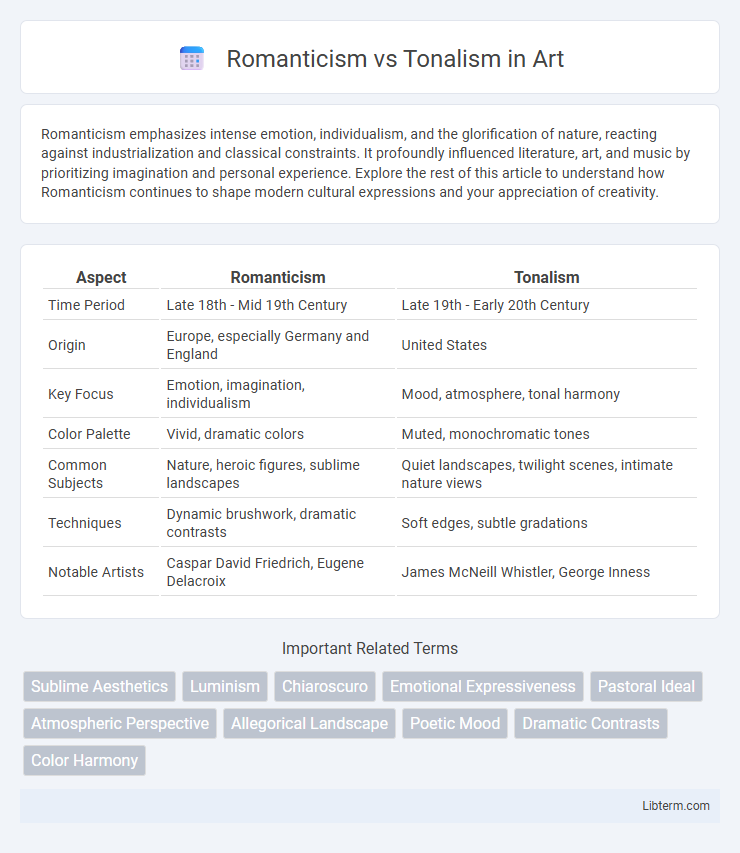Romanticism emphasizes intense emotion, individualism, and the glorification of nature, reacting against industrialization and classical constraints. It profoundly influenced literature, art, and music by prioritizing imagination and personal experience. Explore the rest of this article to understand how Romanticism continues to shape modern cultural expressions and your appreciation of creativity.
Table of Comparison
| Aspect | Romanticism | Tonalism |
|---|---|---|
| Time Period | Late 18th - Mid 19th Century | Late 19th - Early 20th Century |
| Origin | Europe, especially Germany and England | United States |
| Key Focus | Emotion, imagination, individualism | Mood, atmosphere, tonal harmony |
| Color Palette | Vivid, dramatic colors | Muted, monochromatic tones |
| Common Subjects | Nature, heroic figures, sublime landscapes | Quiet landscapes, twilight scenes, intimate nature views |
| Techniques | Dynamic brushwork, dramatic contrasts | Soft edges, subtle gradations |
| Notable Artists | Caspar David Friedrich, Eugene Delacroix | James McNeill Whistler, George Inness |
Defining Romanticism: Origins and Principles
Romanticism, emerging in the late 18th century, originated as a reaction against the Industrial Revolution and Enlightenment rationalism, emphasizing emotion, individualism, and nature's sublime power. Key principles include an idealization of the natural world, a focus on intense personal expression, and a fascination with the mysterious and spiritual aspects of human experience. This movement profoundly influenced literature, art, and music by celebrating creativity and the depth of human emotion over classical order and reason.
Understanding Tonalism: Key Characteristics
Tonalism is characterized by its emphasis on atmosphere and mood, often achieved through muted color palettes and soft, blended brushstrokes that create a harmonious, tonal unity across the canvas. Unlike Romanticism's dramatic and emotional intensity, Tonalism focuses on subtle gradations of light and shadow to evoke a quiet, introspective feeling. Key features include limited color ranges, often dominated by earth tones and a preference for twilight or misty landscapes that suggest tranquility and contemplation.
Historical Context: Emergence of the Movements
Romanticism emerged in the late 18th century as a reaction to the Industrial Revolution and Enlightenment rationalism, emphasizing emotion, nature, and individualism. Tonalism developed in the late 19th century, influenced by Impressionism and Japanese aesthetics, focusing on mood and muted color palettes to evoke atmosphere. These movements reflect distinct historical responses to cultural shifts, with Romanticism rooted in revolutionary ideals and Tonalism shaped by urbanization and modernity.
Leading Artists: Iconic Figures in Romanticism and Tonalism
Leading artists in Romanticism include Caspar David Friedrich, known for his evocative landscapes emphasizing emotion and nature's sublime power, and J.M.W. Turner, whose dramatic use of light and color captures intense atmospheric effects. Tonalism's iconic figures, such as James McNeill Whistler and George Inness, focus on muted color palettes and soft, diffused light to evoke mood and introspection, contrasting with Romanticism's dynamic and emotional intensity. These artists' distinct styles highlight the philosophical shift from Romantic idealism to Tonalism's emphasis on tonal harmony and ambiance.
Artistic Techniques: Brushwork, Color, and Composition
Romanticism emphasizes dramatic brushwork with energetic, sweeping strokes that convey emotion, using bold, vibrant colors to evoke mood and dynamic compositions centered on heroic or sublime subjects. Tonalism features soft, blended brushwork creating smooth transitions, subdued, muted color palettes dominated by grays, browns, and blues, and balanced, harmonious compositions that prioritize atmospheric effects and intimate landscapes. Both movements manipulate brushwork, color, and composition distinctively to convey their respective emotional and aesthetic goals.
Depiction of Nature: Awe vs Mood
Romanticism emphasizes the awe-inspiring power of nature, portraying vast, dramatic landscapes that evoke strong emotional responses and highlight the sublime forces of the natural world. Tonalism focuses on mood and atmosphere, using muted color palettes and soft, diffused light to create intimate, contemplative scenes that suggest tranquility and introspection. The Romantic approach often depicts nature as overwhelming and majestic, while Tonalism interprets it through a subtle, poetic lens that captures quiet moods and fleeting moments.
Emotional Intent: Expressive Drama vs Subtle Atmosphere
Romanticism emphasizes expressive drama through bold colors, dynamic compositions, and intense emotional content designed to evoke awe and passion. Tonalism focuses on subtle atmosphere by using muted palettes, soft transitions, and delicate light to create mood and introspection. The emotional intent in Romanticism seeks to captivate with grandeur, while Tonalism invites quiet reflection and nuanced feelings.
Symbolism and Subject Matter: Themes and Motifs
Romanticism emphasizes emotional intensity and dramatic symbolism often through nature's sublime landscapes, using motifs like storms, ruins, and heroic figures to evoke individual passion and transcendence. Tonalism centers on mood and atmosphere, employing muted palettes and soft gradations to symbolize quiet introspection and the fleeting effects of light in serene, often melancholic scenes. Both movements use symbolism to convey deeper meanings, but Romanticism dramatizes human experience, while Tonalism reflects subtle emotional states and the intimate connection between viewer and environment.
Influence and Legacy: Impact on Modern Art
Romanticism profoundly influenced modern art by emphasizing emotion, individualism, and dramatic landscapes, inspiring later movements like Expressionism and Symbolism. Tonalism contributed to modern art through its subtle color palettes and atmospheric effects, laying groundwork for American Impressionism and Abstract Expressionism. Both movements shaped contemporary aesthetics by prioritizing mood and subjective experience over realistic representation.
Romanticism vs Tonalism: Key Differences Summarized
Romanticism emphasizes dramatic, emotional expression and vibrant color contrasts to capture the sublime and individual experience, while Tonalism focuses on muted palettes, soft transitions, and atmospheric effects to evoke mood and tranquility. Romantic artworks often depict heroic nature and dynamic compositions, contrasting with Tonalism's preference for intimate, serene landscapes and subtle tonal harmonies. The key difference lies in Romanticism's intensity and narrative versus Tonalism's calmness and tonal unity.
Romanticism Infographic

 libterm.com
libterm.com